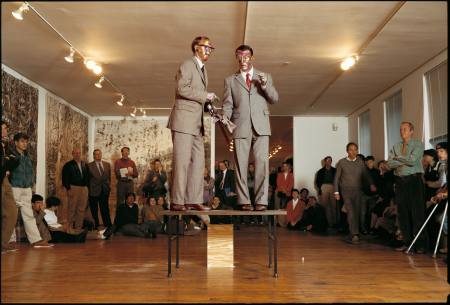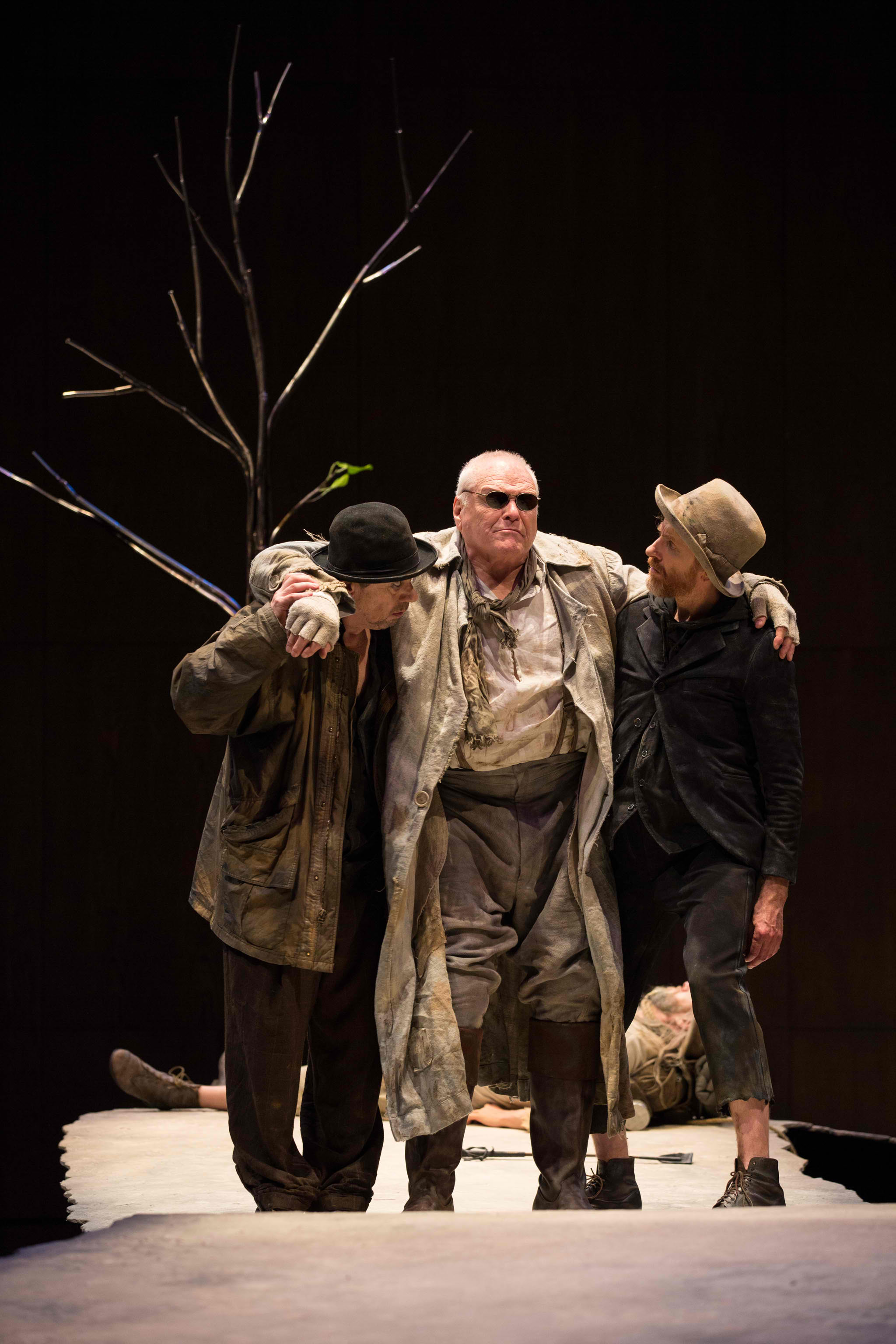Underneath the Arches: Waiting For Godot At Stratford

Something like twenty years ago, I saw a film of the British artists Gilbert and George doing their Singing Sculpture act. In case you’re not familiar with the piece, which they debuted in 1970, the pair of artists painted their faces and hands with metallic paint, climbed up on a small platform, and “danced” (and lip-synched) to an old 1930’s-era number called “Underneath the Arches” in which a homeless fellow sings about sleeping under bridges.
In the particular incarnation I saw, which was staged for the camera, their clothes as well as their faces and hands were painted with metallic paint, and the cane one of them (I can’t remember if it was Gilbert or George) carried was a plastic child’s toy with a squeak on the end. He used the squeak to punctuate the song as he danced. When the song ended, one of them would get off, rewind the tape on the tape recorder, press play, climb back up and start again. On the film they kept this up for maybe twenty minutes. In real life, as I understand it, they would do it for hours.
The film affected me deeply – terrified me, in fact. Probably I was just young, but it felt like an expression of a kind of primal truth of the meaninglessness repetition of life, and the comical absurdity of art. I had dreams – nightmares, really – about it for months after.
I told people at the time that it reminded me of Beckett, and of Waiting for Godot in particular. But in maturer years, I came to wonder about that identification. Beckett wrote Godot in part in response to his experiences in the French resistance. He abstracted from his experiences to something universal, but that sensation of waiting in a bleak landscape for a message, a job to do, that might well never come – that began with something specific. And behind that is Beckett’s Irishness, and the endemic poverty that, back then, afflicted the emerald isle. Vladimir and Estragon are stage vaudevillians, but they are also classic Irish poor-mouth types, and the narrow social horizons of their world – they are free, but penniless; Lucky is lower, a slave; Pozzo higher, a landowner, and wealthy, but largely because he owns a slave – mirror the relatively simple (compared to England) class system in Ireland.
By contrast, Gilbert and George appropriating a song about homelessness are highly suspect. They are a pair of famously elegant gentlemen. Inasmuch as they are making a work of art about privation, it’s a spiritual privation – quiet desperation rather than urgent physical need. Are they not possibly taking something with a social history and, well, mocking it? Or are they commenting on the original song, on the process of making art out of human misery? If we’re going to have lip-synching homeless men, wouldn’t this be a better start?
I thought about all these things the two times I saw this season’s marvelous Stratford production of Waiting For Godot. (Which, by the way, I am very sorry not to have reviewed until now, though it seems to have sold very well without any help from me.) It is hard for me to imagine a better treatment of the play. Jennifer Tarver is one of my favorite directors, and Beckett is right smack in the middle of her wheelhouse. Tom Rooney and Stephen Ouimette are perfectly paired as Vladimir and Estragon, Rooney all long limbs in too-short pants and jacket, Ouimette’s face turned into the mask of a sad clown to match his baggy pants and unlaced boots. Every vaudeville trick is done to a turn, even the hat-swapping bit in the second act. Brian Dennehy makes a genuinely imposing Pozzo, secure in his natural right to rule in the first act, Lear-like in his ruined dignity in the second. And Randy Hughson nearly walks off with the show with his rendition of Lucky’s incoherent stemwinder speech, delivered like a demented Presbyterian preacher from someone out on the Canadian plains. Designer Teresa Przybylski even figured out how to liven up the simple set, traversing the stage with an undulating white ribbon of road on which the action plays out, bordered on both sides by a slick fathomless black.

I had a marvelous time at the show, laughing ’til I cried, then coming up short over and over as the essential horror of their situation came straight home.
But the more I meditated on the piece, the more I worried about it, and about my reaction. Not about the production, which was really just about flawless, but with my – our – relationship with the play. Theirs is a very comfortable existential crisis for us to experience vicariously, because when we see Vladimir and Estragon, we see stage tramps. That’s not a consequence of the performances, which are completely sincere (they have to be, or they wouldn’t be so funny); it’s a consequence of social change since Beckett’s day. We – the theater-going audience – are just much further away from real tramps than a mid-century audience might have been. George Orwell could go “tramping” and it could play as an eccentricity. Today, that level of eccentricity makes you William T. Vollmann – or, worse, a reality-television star.
There is plenty that we do share with Didi and Gogo, from Vladimir’s desperate need to be seen, and recognized, by the boy messenger of Godot, to Estragon’s inability to remember anything that happens to him (except being beaten); and from Estragon’s shoes that won’t fit to Vladimir’s desperate need to urinate. But we – a typical theater audience – don’t share their fundamental privation. Can we still laugh at them in good conscience and feel that privation as real? Or do we laugh at them in good conscience because we spiritualize their physical situation, turn them into friendlier symbols?
I wonder what would happen if we played them, not as stage types, but as types from life. If we tried to bridge the gap between these tramps and the fellows who actually do lie underneath the arches. Would we be awakened to pity? Or would we see something a bit, well, Stepin Fetchit about their vaudevilles?
Comments